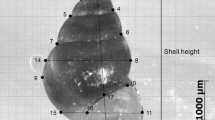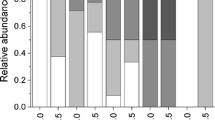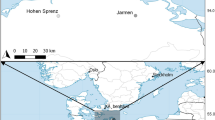Abstract
Interspecific interactions between parasites and hosts can influence the evolution of behavioural and morphological adaptations of both parasites and their hosts. There is, however, little empirical evidence available regarding the evolution of reproductive traits driven by these interactions. In this paper, we investigated host selection and ovipositor length in nine sympatric marine sculpins that oviposit into tunicates or sponges. Field and genetic studies have revealed host use for eight out of nine species of sculpins investigated here: five species of Pseudoblennius, two species of Furcina and one species of Vellitor. For one species studied (V. minutus), no egg masses could be found. Ovipositor length reflects morphology of host species utilised: six sculpin species had extremely long ovipositors allowing females to attach eggs to the deep atrium of solitary tunicates, whereas the two species that attached their eggs to the small space of atrial siphon of colonial tunicates and the spongocoel of sponges had short ovipositors. Ovipositor length varied between solitary-tunicate spawners and species with longer ovipositors selected larger tunicates. Since the ancestral form is non-parasitic, the ovipositor evolved as an adaptation to utilise sponges and tunicates as hosts. Sculpins found sympatrically may show host specificity to avoid interspecific competition for spawning niches and ovipositors may have evolved depending on the species and size of host invertebrates.





Similar content being viewed by others
References
Abe T, Munehara H (2009) Adaptation and evolution of reproductive mode in copulating cottoid species. In: Jamieson BGM (ed) Reproductive biology and phylogeny of fishes (agnathans and bony fishes). Science Publishers, Enfield, pp 221–246
Akagawa I, Hara M, Iwamoto T (2008) Egg concealment in tunicates by females of the Japanese tubesnout, Aulichthys japonicus (Gasterosteiformes), and its subsequent copulation. Ichthyol Res 55:85–89
Andersson M (1994) Sexual selection. Princeton Univ. Press, Princeton
Awata S (2015) Diversity and evolution of reproductive strategies in marine sculpins. Aquabiol 37:614–621
Awata S (2017) Taxonomic and ecological notes on marine sculpins on the coast of Sado Island in the Sea of Japan. Nat Hist Sado Isl 5:9–20
Balon EK (1975) Reproductive guilds of fishes—proposal and definition. J Fish Res Board Can 32:821–864
Birkhead TR, Møller AP (1998) Sperm competition and sexual selection. Academic Press, London
Busby MS, Blood DM, Fleischer AJ, Nichol DG (2012) Egg deposition and development of eggs and larvae of bigmouth sculpin (Hemitripterus bolini). Northwest Nat 93:1–16
Dunn CW, Giribet G, Edgecombe GD, Hejnol A (2014) Animal phylogeny and its evolutionary implications. Annu Rev Ecol Evol Syst 45:371–395
Elias LG, Kjellberg F, Farache FHA, Almeida EAB, Rasplus J-Y, Cruaud A, Peng Y-Q, Yang D-R, Pereira RAS (2018) Ovipositor morphology correlates with life history evolution in agaonid fig wasps. Acta Oecol 90:109–116
Gardner JR, Orr JW, Stevenson DE, Spies I, Somerton DA (2016) Reproductive parasitism between distant phyla: molecular identification of snailfish (Liparidae) egg masses in the gill cavities of king crabs (Lithodidae). Copeia 104:645–657
Ghara M, Kundanati L, Borges RM (2011) Nature’s Swiss Army knives: ovipositor structure mirrors ecology in a multitrophic fig wasp community. PLoS One 6:e23642
Hunter CJ (1969) Confirmation of symbiotic relationship between liparid fishes (Careproctus spp.) and male king crab (Paralithodes camtschatica). Pac Sci 23:546–547
Iwata A (1983) A revision of the cottid fish genus Vellitor. Jpn J Ichthyol 30:1–9
Keenleyside MHA (1991) Parental care. In: Keenleyside MHA (ed) Cichlid fishes: behaviour, ecology and evolution. Chapman and Hall, London, pp 191–208
Kimura S, Tsumoto K, Mori K (1987) Development of eggs, larvae and juveniles of the cottid fish, Pseudoblennius cottoides, reared in the laboratory. Jpn J Ichthyol 34:346–350
Kimura S, Tsumoto K, Mori K (1988) Development of the cottid fish, Pseudoblennius percoides, reared in the laboratory, with brief descriptions of juvenile P. marmoratus and P. zonostigma. Jpn J Ichthyol 35:19–24
Kitamura J (2005) Factors affecting seasonal mortality of rosy bitterling (Rhodeus ocellatus kurumeus) embryos on the gills of their host mussel. Popul Ecol 47:41–51
Kitamura J (2007) Reproductive ecology and host utilization of four sympatric bitterling (Acheilognathinae, Cyprinidae) in a lowland reach of the Harai River in Mie, Japan. Environ Biol Fish 78:37–55
Kitamura J, Nagata N, Nakajima J, Sota T (2012) Divergence of ovipositor length and egg shape in a brood parasitic bitterling fish through the use of different mussel hosts. J Evol Biol 25:566–573
Knope ML (2013) Phylogenetics of the marine sculpins (Teleostei: Cottidae) of the North American Pacific Coast. Mol Phylogenet Evol 66:341–349
Koya Y, Hayakawa Y, Markevich A, Munehara H (2011) Comparative studies of testicular structure and sperm morphology among copulatory and non-copulatory sculpins (Cottidae: Scorpaeniformes: Teleostei). Ichthyol Res 58:109–125
Koya Y, Mitsuhashi N, Awata S, Ito T, Munehara H (2015) Identification of the reproductive mode for internal gamete association in Vellitor centropomus (Cottidae): gonadal histological analysis. Japan J Ichthyol 62:121–131
Kumar S, Stecher G, Tamura K (2016) MEGA7: molecular Evolutionary Genetics Analysis version 7.0 for bigger datasets. Mol Biol Evol 33:1870–1874
Le Ralec A, Rabasse JM, Wajnberg E (1996) Comparative morphology of the ovipositor of some parasitic Hymenoptera in relation to characteristics of their hosts. Can Entomol 128:413–433
Leung TLF (2014) Fish as parasites: an insight into evolutionary convergence in adaptations for parasitism. J Zool 294:1–12
Love DC, Shirley TC (1993) Parasitism of the golden king crab, Lithodes aequispinus Benedict, 1895, by a liparid fish. Crustaceana 65:97–104
Mehbub MF, Lei J, Franco C, Zhang W (2014) Marine sponge derived natural products between 2001 and 2010: trends and opportunities for discovery of bioactives. Mar Drugs 12:4539–4577
Mills SC, Reynolds JD (2002) Mussel ventilation rates as approximate cue for host selection by bitterling, Rhodeus sericeus. Oecologia 131:473–478
Mills SC, Reynolds JD (2003) The bitterling-mussel interaction as a test case for co-evolution. J Fish Biol 63:84–104
Momota K, Munehara H (2017) Reproductive ecology and morphological changes during the early life stages of Pallasina barbata (Steindachner, 1876). Bull Fish Sci Hokkaido Univ 67:7–12
Munehara H (1991) Utilization and ecological benefits of a sponge as a spawning bed by the little dragon sculpin Blepsias cirrhosis. Jpn J Ichthyol 38:179–184
Munehara H, Takano K, Koya Y (1989) Internal gametic association and external fertilization in the elkhorn sculpin, Alcichthys alcicornis. Copeia 1989:673–678
Munehara H, Goto A, Yabe M (2011) Diversity of cottoid fishes—adaptation and evolution. Tokai Univ Press, Kanagawa
Nakabo T, Kai Y (2013) Cottidae. In: Nakabo T (ed) Fishes of Japan with pictorial keys to the species, 3rd edn. Tokai University Press, Hadano, pp 1160–1188
Nelson JS, Grande TC, Wilson MVH (2016) Fishes of the World, 5th edn. Wiley, East Orange
Nishida T, Inui R, Onikura N (2008) A note on the spawning bed of Pseudoblennius percoides (Scorpaeniformes, Cottidae) in shallow sea areas around coastal Fukutsu, northern Kyusyu Island, Japan. Biogeography 10:45–51
Okamura O, Amaoka K (eds) (1997) Seawater fishes in Japan. Yamatokeikoku-sha, Tokyo
Palumbi SR (1996) What can molecular genetics contribute to marine biogeography? An urchin’s tale. J Exp Mar Biol Ecol 203:75–92
Paul VJ, Puglisi MP (2004) Chemical mediation of interactions among marine organisms. Nat Prod Rep 21:189–209
Paul VJ, Puglisi MP, Ritson-Williams R (2006) Marine chemical ecology. Nat Prod Rep 23:153–180
Peden AE, Corbett CA (1973) Commensalism between a liparid fish, Careproctus sp., and the lithodid box crab, Lopholithodes foraminatus. Can J Zool 51:555–556
Poltev YN, Mukhametov IN (2009) Concerning the problem of carcinophilia of Careproctus species (Scorpaeniformes: Liparidae) in the North Kurils. Russ J Mar Biol 35:215–223
Reichard M, Ondrackova M, Przybylski M, Liu H, Smith C (2006) The costs and benefits in an unusual symbiosis: experimental evidence that bitterling fish (Rhodeus sericeus) are parasites of unionid mussels in Europe. J Evol Biol 19:788–796
Reichard M, Liu H, Smith C (2007) The co-evolutionary relationship between bitterling fishes and freshwater mussels: insights from interspecific comparisons. Evol Ecol Res 9:239–259
Schmidt TR, Gold JR (1993) Complete sequence of the mitochondrial cytochrome b gene in the cherryfin shiner, Lythrurus roseipinnis (Teleostei: Cyprinidae). Copeia 1993:880–883
Shinomiya A (1985) Studies on the reproductive physiology and ecology in three marine cottid fish. Dissertation, Hokkaido University
Shinomiya A, Ikemoto M (1987) Spawning habits of the sculpin Pseudoblennius percoides in relation to sea squirt. In: Advance abstracts for the 20th annual meeting, The Ichthyological Society of Japan
Shiogaki M, Dotsu Y (1974) The spawning of the sea sculpin, Pseudoblennius cottoides. Bull Fac Fish Nagasaki Univ 38:71–76
Smith C, Rippon K, Douglas A, Jurajda P (2001) A proximate cue for oviposition site choice in the bitterling (Rhodeus sericeus). Freshw Biol 46:903–911
Smith C, Reichard M, Jurajda P, Przybylski M (2004) The reproductive ecology of the European bitterling (Rhodeus sericeus). J Zool 262:107–124
Somerton DA, Donaldson W (1998) Parasitism of the golden king crab, Lithodes aequispinus, by two species of snailfish, genus Careproctus. Fish Bull 96:871–884
Spence R, Smith C (2013) Rose bitterling (Rhodeus ocellatus) embryos parasitize freshwater mussels by competing for nutrients and oxygen. Acta Zool 94:113–118
Stoecker D (1980) Chemical defenses of ascidians against predators. Ecology 61:1327–1334
Tamura K, Nei M (1993) Estimation of the number of nucleotide substitutions in the control region of mitochondrial-DNA in humans and chimpanzees. Mol Biol Evol 10:512–526
Uchida K (1932) Fish laying eggs in the body of tunicates. Kagaku 2:56–57
Uchida K (1979) Chigyo Wo Motomete. Iwanamisyoten, Tokyo
Uryu T (2011) Marine fishes of Izu. Kaiyusha, Tokyo
Yabe M (1985) Comparative osteology and myology of the superfamily Cottoidea (Pisces: Scorpaeniformes), and its phylogenetic classification. Mem Fac Fish Hokkaido Univ 32:1–130
Acknowledgements
We thank Teruaki Nishikawa and Yuji Ise for help with the classification of tunicates and sponges. We are also grateful to Mitsuo Homma (Diving Service F. Wave), Ryo Honma (Sado Diving Centre), Yoshihisa Sato (Senkakuwan Ageshima Aquarium), Akihiro Yamada, Hiromitsu Takashima (Ogi Diving Centre), Tadashi Shoji (Diving Service S. World), Sadogashima SCUBA Diving Association and Kitakoura Recreational Fishing Cooperative for support in the field. We would like to thank Tomonobu Uryu for creating videos for us and Editage (http://www.editage.jp) for English language editing. The anonymous reviewers provided helpful comments on the manuscript. The project was financially supported in part by JSPS KAKENHI Grant Numbers JP24770016 and JP16H04841 to S.A., JP26450259 to Y.K. and JP25304011 to H.M. and by the Sasaki Environment Technology Foundation (H26) to S.A.
Author information
Authors and Affiliations
Corresponding author
Ethics declarations
Ethical statement
The research reported in this study was carried out in accordance with Animal Care and Use Committees at Niigata University and Osaka City University. All of the procedures described above meet the ABS/ASAB guidelines for the ethical treatment of animals. Research permission was obtained from Fisheries Cooperative Association of Sado, Japan.
Additional information
Responsible Editor: C. Eizaguirre.
Publisher's Note
Springer Nature remains neutral with regard to jurisdictional claims in published maps and institutional affiliations.
Reviewed by Undisclosed experts.
Electronic supplementary material
Below is the link to the electronic supplementary material.
Movie S1 Spawning behaviours of female Pseudoblennius cottoides in the aquarium. Six Halocynthia ritteri on wire-netting were placed in a 75 × 45 × 45 cm aquarium. Eggs were deposited in the atrium of a tunicate through the atrial siphon using extremely long ovipositors. Eggs were probably released into the atrium when the female opened her mouth. The female stayed still on the tunicate after spawning. She ejected her ovipositor 1 min 22 sec and left the tunicate 2 min 34 sec after the insert, respectively (not shown). This movie was filmed by H. S. on Feb. 7, 2015. Fish and tunicates were collected on the coast of Sado Island in the Sea of Japan. (M4V 7441 kb)
Movie S2 Failure of spawning by female Pseudoblennius cottoides in the aquarium. The atrial siphon of the tunicate closed before the sculpin female inserted her ovipositor. Settings were the same as in Movie S1. This movie was filmed by H. S. on Feb. 1, 2015. (M4V 5619 kb)
Movie S3 Spawning behaviours of female Pseudoblennius marmoratus in the field. Eggs were deposited in the spongocoel of a sponge using short ovipositors. This movie was filmed by Tomonobu Uryu on Dec. 28, 2009 at Izu Oceanic Park, Izu Peninsula, Pacific coast of Japan. Water temperature was about 16 °C and water depth was about 5 m. (M4V 11238 kb)
Rights and permissions
About this article
Cite this article
Awata, S., Sasaki, H., Goto, T. et al. Host selection and ovipositor length in eight sympatric species of sculpins that deposit their eggs into tunicates or sponges. Mar Biol 166, 59 (2019). https://doi.org/10.1007/s00227-019-3506-4
Received:
Accepted:
Published:
DOI: https://doi.org/10.1007/s00227-019-3506-4




